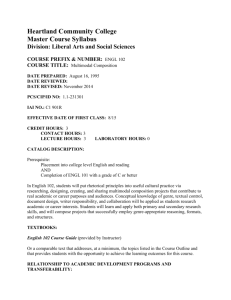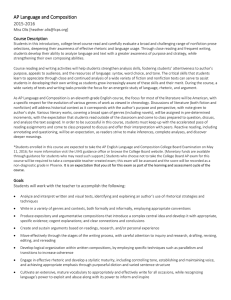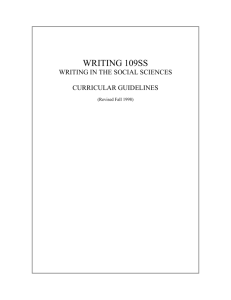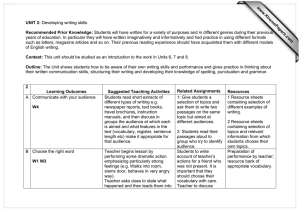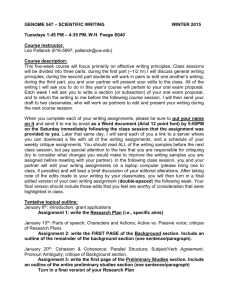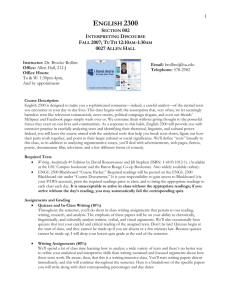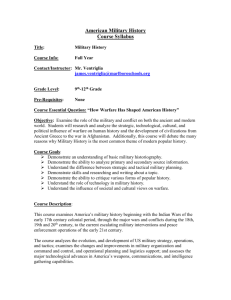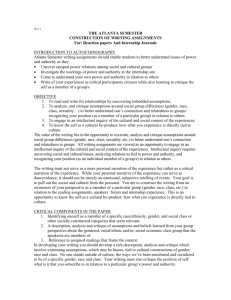ENGL101_2015-08 - Heartland Community College
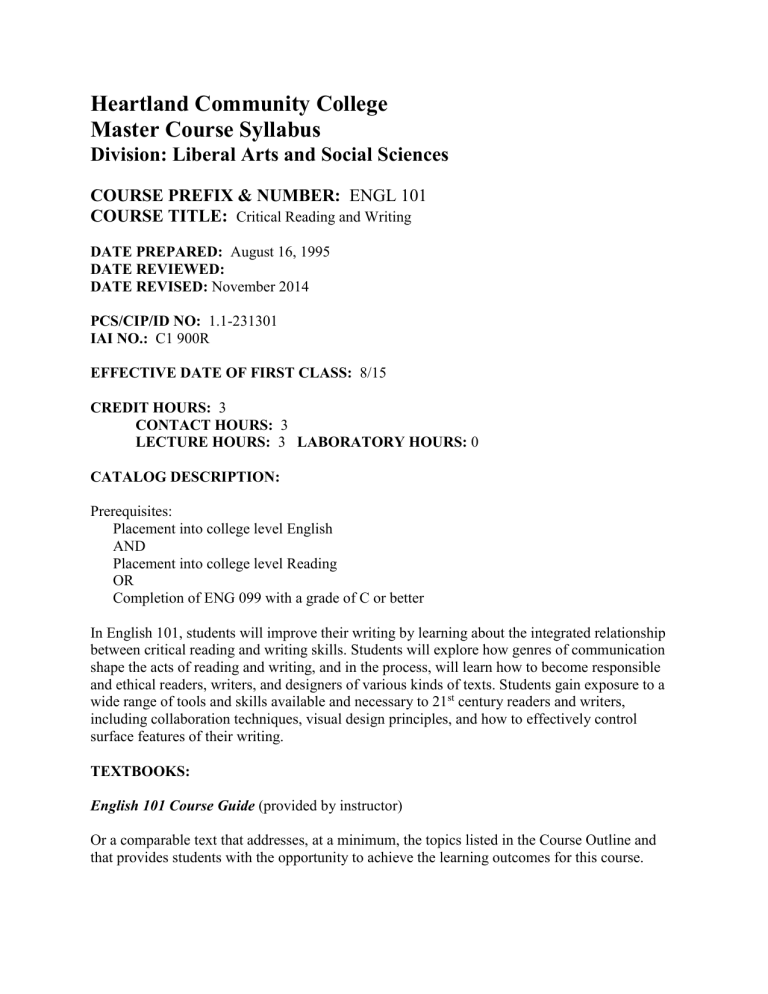
Heartland Community College
Master Course Syllabus
Division: Liberal Arts and Social Sciences
COURSE PREFIX & NUMBER:
ENGL 101
COURSE TITLE:
Critical Reading and Writing
DATE PREPARED: August 16, 1995
DATE REVIEWED:
DATE REVISED: November 2014
PCS/CIP/ID NO: 1.1-231301
IAI NO.: C1 900R
EFFECTIVE DATE OF FIRST CLASS: 8/15
CREDIT HOURS: 3
CONTACT HOURS: 3
LECTURE HOURS: 3 LABORATORY HOURS: 0
CATALOG DESCRIPTION:
Prerequisites:
Placement into college level English
AND
Placement into college level Reading
OR
Completion of ENG 099 with a grade of C or better
In English 101, students will improve their writing by learning about the integrated relationship between critical reading and writing skills. Students will explore how genres of communication shape the acts of reading and writing, and in the process, will learn how to become responsible and ethical readers, writers, and designers of various kinds of texts. Students gain exposure to a wide range of tools and skills available and necessary to 21 st
century readers and writers, including collaboration techniques, visual design principles, and how to effectively control surface features of their writing.
TEXTBOOKS:
English 101 Course Guide (provided by instructor)
Or a comparable text that addresses, at a minimum, the topics listed in the Course Outline and that provides students with the opportunity to achieve the learning outcomes for this course.
RELATIONSHIP TO ACADEMIC DEVELOPMENT PROGRAMS AND
TRANSFERABILITY:
ENGL 101 fulfills 3 of the 9 semester hours of credit in Communication required for the
A.A. or A.S. degree. This course should transfer as part of the General Education Core
Curriculum described in the Illinois Articulation Initiative to other Illinois colleges and universities participating in the IAI. However, students should consult an academic advisor for transfer information regarding particular institutions. Refer to www.iTransfer.org
for information.
Learning Outcomes
Course Outcomes Essential Program
Competencies Outcome
Range of Assessment Methods
Identify & describe multiple modes of information
Articulate the role of conventions in shaping & designing rhetorical situations
Articulate how genres shape reading & writing
Identify & define rhetorical concepts
Contribute, through writing, their own ideas & opinions about a topic to an ongoing conversation in ways that are appropriate to the academic discipline or other context
Practice efficient research methods by locating & organizing research materials
Read critically through comprehension, analysis & critique of a variety of texts
Write about texts for multiple purposes including (but not limited to) interpretation, synthesis, response, summary, critique & analysis
Recognize and navigate the ethical responsibilities required by complex environments
Recognize the importance of collaboration in textual production
CT 1
CT 2
CO 3
CO 5
CO 4
DI 1
PO1 Projects such as an essay, blog post, feature article, persuasive
PO1 editorial, etc.
PO2
Process Assignments , which may include but are not limited
PO2
PO3 to, invention exercises (e.g., listing, concept mapping, claim structure outlining, etc.), topic proposals, annotated
PO4
PO4 bibliographies, drafting, peer review, documentation practice, revision, editing, inclass assignments (individual and collaborative), class discussion of writing or readings, attendance, and quizzes.
PO4
PO5
PO6
Control the appropriate surface features of a text, including (but not limited to) syntax, grammar, punctuation, spelling,
& documentation
PO7
Essential Competencies:
DI 1 (Diversity Outcome 1): Domain Level—Valuing; “Students reflect upon the formation of their own perspectives, beliefs, opinions, attitudes, ideals, and values.”
CO 3 (Communications Outcome 3):”Students listen in order to comprehend information, critique and evaluate a message, show empathy for the feelings expressed by others, and/or appreciate a performance.”
CO 4(Communications Outcome 4): “Students are self-reflective of the communications process.”
CO 5 (Communications Outcome 5): “Students communicate ethically through monitoring their behavior and interactions with others.”
CT 1(Critical Thinking Outcome 1): “Students gather knowledge, apply it to a new situation, and draw reasonable conclusions in ways that demonstrate comprehension.”
CT 2 (Critical Thinking Outcome 2): “Students determine value of multiple sources or strategies and select those most appropriate in a given context.”
Program Outcomes:
1.
Teach students to recognize and critique the constructed nature of information
2.
Teach students how to employ appropriate multi-modal strategies
3.
Identify and demonstrate to students how to transfer learning and understanding between genres via metacognition
4.
Model and foster intellectual curiosity by exploring and building upon new ideas, questions, and topics
5.
Teach students to locate and synthesize a wide range of ideas and perspectives
6.
Introduce and engage in collaboration
7.
Teach students appropriate writing features and processes
COURSE/LAB OUTLINE:
Elements of the writing process
Principles of organization and development
Principles of design
Identifying purpose and audience
Use of Sources and Ethical behavior
Revision strategies
Researching for different environments
Writing for different genres
Uses of technology in writing, sharing, and publication
METHOD OF EVALUATION: Student assessment will be based on the following:
Projects: 50%
In total, there will be 3-5 projects, 2 of which will total the equivalent of at least 10 revised pages
(2500 words or more) and include the use of multiple sources.
Process Assignments: 50%
Process assignments may include but are not limited to invention exercises (e.g., listing, concept mapping, claim structure outlining, etc.), topic proposals, annotated bibliographies, drafting, peer review, documentation practice, revision, editing, in-class assignments (individual and collaborative), class discussion of writing or readings, attendance related participation, and quizzes.
Final grades will be determined according to the following scale:
90 to 100% = A
80 to 89% = B
70 to 79% = C
60 to 69% = D
Below 59% = F
REQUIRED WRITING AND READING:
During the course, students will explore and play with rhetorical strategies and genre expectations. This course will allow for multiple, shorter learning assignments in order to assess whether students understand those concepts. In total, students will compose between 3-5 projects, 2 of which will total the equivalent of at least 10 pages, or 2,500 words, in revised form.*
Readings from textbooks and other sources are assigned and can average 35 pages per week.
*Estimate is based on a 16 week course schedule. Please note if your class is not a 16 week class your weekly reading assignment will be increased.
